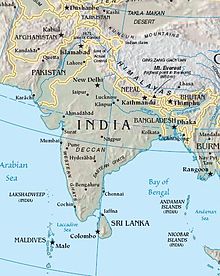| Revision as of 15:01, 14 May 2004 view source220.247.248.205 (talk)No edit summary← Previous edit | Revision as of 15:38, 14 May 2004 view source 220.247.248.205 (talk)No edit summaryNext edit → | ||
| Line 3: | Line 3: | ||
| '''South Asia''' is a subregion of ] comprising the modern states of ], ], ], ], ], ], ], and the ]. It covers about 4,480,000 km<sup>2</sup>, or 10 percent of the continent. | '''South Asia''' is a subregion of ] comprising the modern states of ], ], ], ], ], ], ], and the ]. It covers about 4,480,000 km<sup>2</sup>, or 10 percent of the continent. | ||
| South Asia ranks among the ]'s most crowded places. About 1 1/3 billion people live there—about a third of all ]s and a fifth of all the people in the world. The region's population density of 305 persons per km<sup>2</sup> is more than |
South Asia ranks among the ]'s most crowded places. About 1 1/3 billion people live there—about a third of all ]s and a fifth of all the people in the world. The region's population density of 305 persons per km<sup>2</sup> is more than seven times the world average. | ||
| The region has a long history. Ancient civilisations |
The region has a long history. Ancient civilisations developed in the ] Valley. The region was at its most prosperous before the 17th century, when the ] held sway in the north; ] ] lead to a new conquering of the region, by ] and ], and later ] and to a lesser degree ]. Most of the the region gained independence from Europe in the late ]. | ||
| :''See also: ]'' | :''See also: ]'' | ||
Revision as of 15:38, 14 May 2004

South Asia is a subregion of Asia comprising the modern states of India, Pakistan, Afghanistan, Bangladesh, Sri Lanka, Nepal, Bhutan, and the Maldives. It covers about 4,480,000 km, or 10 percent of the continent.
South Asia ranks among the world's most crowded places. About 1 1/3 billion people live there—about a third of all Asians and a fifth of all the people in the world. The region's population density of 305 persons per km is more than seven times the world average.
The region has a long history. Ancient civilisations developed in the Indus River Valley. The region was at its most prosperous before the 17th century, when the Mughal Empire held sway in the north; European colonialism lead to a new conquering of the region, by Portugal and Holland, and later Britain and to a lesser degree France. Most of the the region gained independence from Europe in the late 1940s.
- See also: History of South Asia
Southern Asia sometimes refers to all of Asia that was not part of the Soviet Union.